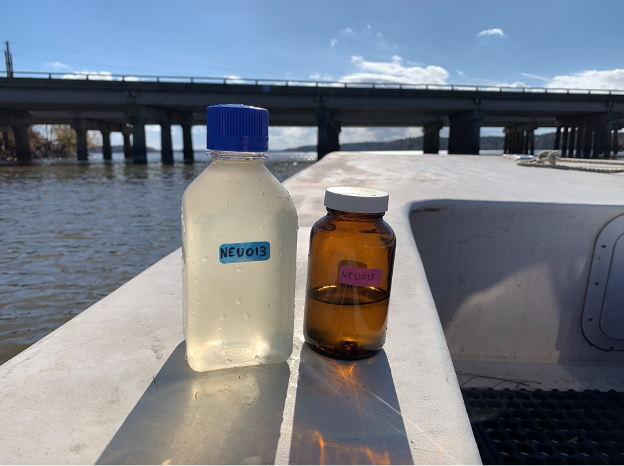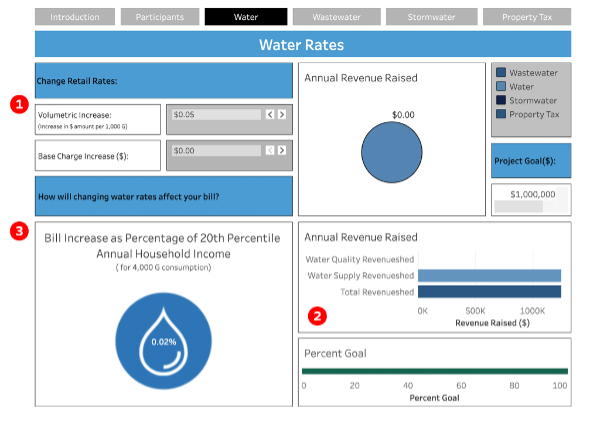By Megan Doherty

Megan Doherty is a project analyst with the UNC Environmental Finance Center. Megan graduated from UNC-Chapel Hill in 2022 with a B.S. in Biology with minors in Environmental Sciences and Mandarin Chinese.
Editor’s note: The UNC Falls Lake Study is a comprehensive evaluation of improving water quality and nutrient management in Falls Lake and throughout the watershed. The study took place between 2019 – 2023 with a final legislative report submitted to the NC General Assembly in December of 2023. The report contains detailed scientific findings and recommendations on more than a dozen topics. One of those topics, paying for nutrient management projects, is the subject of the blog post below, which was originally published on the UNC Environmental Finance Center website.
Living in a nation with plentiful resources, it is often easy to take them for granted. Historically, costs for natural resources have been relatively affordable, especially for water. However, studies show that as pollutants increase, so does the treatment necessary for clean water, consequently increasing the cost of water. This raises questions like “How do we keep water affordable?” and “Should water users or water polluters pay to treat polluted waters?”.
Falls Lake in North Carolina is one of many waterbodies addressing these questions. Falls Lake is a man-made drinking water source for half a million people and is part of the Upper Neuse River Basin (UNRB). After the North Carolina legislature uncovered issues with the health of Falls Lake and surrounding waterbodies, it created a Nutrient Management Strategy, which mandated that municipalities take nutrient reduction actions. In 2016, the NC General Assembly funded a six-year-long nutrient management study extended to seven years due to the COVID-19 pandemic. The study, led by the NC Collaboratory, employed many teams of researchers to assess projects and strategies aimed at managing nutrient-related pollution, including the Environmental Finance Center at UNC (EFC).
With increasing droughts, flooding, chemical impurities, and overall unpredictability with water resources, advanced study and treatment of water will be necessary, and financing these two sectors will be pivotal.
While the legislature funded research on projects to increase the water body’s health, it did not fund the implementation of these projects. That is where the EFC’s research came in. The EFC studied Jordan Lake for three years (2016-2019) and studied Falls Lake for four years (2020-2023).
The center had three main goals:
- Uncover the current and future financing strategies to pay for nutrient management projects.
- Determine the most financially feasible funding strategy for the constituents of Falls Lake.
- Determine if nutrient management funding strategies are transferable between watersheds.
EFC Findings from Years 1-4
In the first year of the study, the EFC developed a strong understanding of the current financial requirements of the Falls Lake Rules. Through stakeholder interviews, the EFC identified the existing streams of revenue used to finance rule compliance and summarized the engagement of nutrient management organizations to understand the potential for multi-jurisdiction compliance. Several jurisdictions had already engaged in multi-jurisdiction compliance, for example the Granville-Person Stormwater Service and the Upper Neuse River Basin Association (UNBRA).

In the second year of the study, the EFC continued to research the current and potential financial streams to fund rule compliance and completed repurposing the Jordan Lake Revenueshed tool into the Falls Lake Revenueshed tool. A Revenueshed is an area where base funds can be raised to finance a specific purpose. Base funding can include utility fees and property tax. In the case of Falls Lake, water utility, sewer utility, stormwater utility, and property tax can be pooled to fund projects contributing to compliance under the Nutrient Management Rules.
The center detailed several nutrient management funding strategies outside of North Carolina, including the Maryland Bay Restoration Fund, which raises money through license plate fees and taxes. By completing the Revenusehed tool, the EFC allowed for easy cross-jurisdictional collaboration to finance nutrient management.
The tool displays:
- How to use incremental fee increases to raise funds across a watershed.
- How small changes in fees can raise significant funds.
- How these small fee changes have minimal financial impacts on low-income customers.
The example below models how an increase in water utility fees by $0.05 per 1,000 gallons across the UNRB could raise $10,000 annually. Additionally, this change would only increase bills for the lower 20th percentile income households by 0.02%.

In year three, the EFC analyzed the affordability of current financing mechanisms in Falls Lake, provided recommendations to mitigate affordability concerns, and shared the positive impacts of the Interim Alternative Implementation Approach’s (IAIA) new financial compliance structure. After finding existing affordability concerns with water bills, the EFC recommended employing two metrics, the AR20 and the Percent of 20th Percentile Annual Household Income. Additionally, the EFC outlined government funding for disadvantaged communities that could simultaneously aid nutrient management. These funds include the Justice40 initiative or Bipartisan Infrastructure Law Funding (BIL). It was found that the IAIA’s new compliance structure would also decrease affordability concerns, offering municipalities more flexibility with nutrient reduction projects.
First, the EFC summarized the obligations of Falls Lake under the Clean Water Act (CWA) and revealed the unclear impacts of a site-specific standard on current legislation. Second, the center compared recommendations from the Jordan and Falls Lake nutrient studies, finding that many were transferable between the two watersheds. Lastly, the financial implications of the longevity and number of funders contributing to nutrient management in Falls Lake were discussed alongside several legislative recommendations revealing that long-term and constant funding is pivotal to maintaining nutrient management practices.
National Impact
The study of Falls Lake is a scientific and financial success for constituents of the UNRBA and waterbodies across the nation. With increasing droughts, flooding, chemical impurities, and overall unpredictability with water resources, advanced study and treatment of water will be necessary, and financing these two sectors will be pivotal. The model of deep collaboration, scientific innovation, and financial analysis created in the Nutrient Management study lays a strong foundation for mitigating the nation’s impending water needs issues.
For more information about the UNC Falls Lake Study visit: https://nutrients.web.unc.edu/

